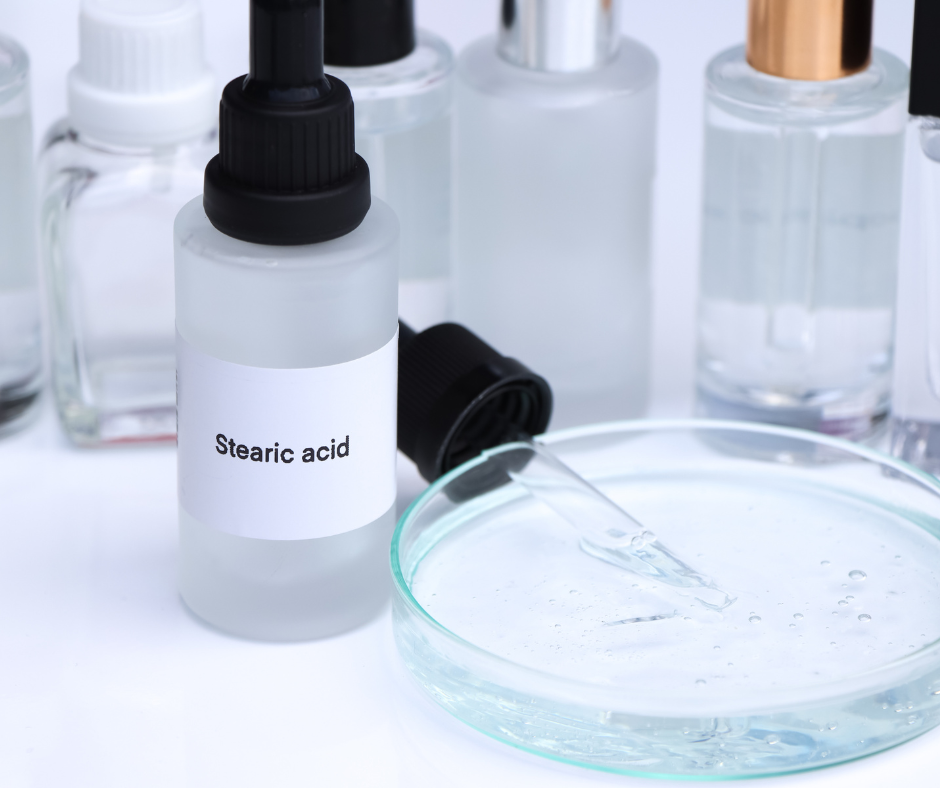Stearic Acid: The Unsung Hero in Your Skincare Arsenal

Ever squint at the ingredients list on your favourite moisturiser and feel like you're deciphering ancient Egyptian hieroglyphics? Fear not, fellow skincare adventurer! Today, we're cracking the code on a superstar ingredient hiding in plain sight: stearic acid.

While some components boast exotic names and seemingly magical properties, stearic acid, a humble fatty acid, plays a vital role in keeping your skin healthy. Think of it as the unsung hero behind that radiant glow you crave.
Intrigued? Buckle up, because we're about to delve deep into the world of stearic acid. We'll answer all your burning questions, like:
- What exactly is stearic acid, and where does it come from?
- How does it work its magic on your skin?
- Is it safe for everyone?
- Where can you find this wonder ingredient hiding in your skincare products?
Whether you're a seasoned skincare enthusiast or simply curious about the potions and lotions lining your bathroom shelf, this post will shed light on why stearic acid might be the missing piece in your healthy skin journey.
Stearic Acid: The Building Block of Healthy Skin
Imagine stearic acid as a tiny building block, a naturally occurring molecule found in both plants and animals. It might not look glamorous (it's a waxy solid at room temperature!), but it plays a crucial role in the structure and function of various biological systems, including our skin.

There are two main sources of stearic acid used in skincare:
- Plant Power: Calling all vegans and vegetarians! Cocoa butter, shea butter, and olive oil are all rich in stearic acid. These natural sources offer a fantastic option for those seeking plant-based skincare solutions.
- Animal Allies: Tallow, derived from rendered beef fat, is another source of stearic acid. While this option might not be suitable for everyone, it offers similar benefits for skin health.
Once incorporated into your favourite skincare products, stearic acid undergoes a fascinating transformation. Through a process called saponification, it teams up with an alkali (like sodium hydroxide) to create the cleansing agents and emollients that keep your skin feeling squeaky clean and oh-so-soft.
The Many Hats of Stearic Acid: Unveiling Its Skin Benefits
Stearic acid isn't just another ingredient on the label – it's a multi-talented wonder worker for your skin:
- Moisture Master: Dry or dehydrated skin? Stearic acid comes to the rescue! It acts as an emollient, meaning it helps trap moisture in your skin, creating a healthy barrier and keeping it feeling soft and supple. Think of it as a tiny shield against the elements.
- Lathering Legend: Stearic acid plays a key role in creating that rich, creamy lather in your soaps and cleansers. This lather helps remove dirt, oil, and impurities, leaving your skin feeling clean and refreshed. But remember, a gentle lather is key – overly harsh lathering can be drying. Opt for cleansers that strike the perfect balance!
- Texture Tycoon: Ever wonder why your favourite moisturiser has such a luxurious feel? Stearic acid might be the secret ingredient! It helps thicken and stabilise various skincare products, ensuring a smooth, creamy texture and consistent performance over time.
- Potential Anti-Inflammatory Ally: While research is ongoing, some studies suggest stearic acid might possess anti-inflammatory properties. This could be good news for those dealing with conditions like eczema or psoriasis, where inflammation plays a role.
- Sensitive Skin Saviour: Due to its similarity to the fatty acids naturally found in human sebum (skin oil), stearic acid is generally well-tolerated by most skin types and less likely to cause irritation compared to some synthetic ingredients. This makes it a great option for those with sensitive skin.
Is Stearic Acid a Perfect Match for Everyone?
The good news is that stearic acid is generally safe for most skin types, even sensitive skin. However, there are a few things to keep in mind:
- Oily Complexions Beware: If you have oily skin, a product with a high concentration of stearic acid might feel a bit heavy or greasy. Opt for lighter formulations or products with ingredients that help balance oil production.
- The Comedogenic Conundrum: Some sources list stearic acid as comedogenic, meaning it may clog pores and contribute to breakouts. However, the comedogenic scale isn't always reliable, and everyone's skin reacts differently. If you're prone to acne, it's always best to do a patch test first.

Where to Find Stearic Acid: Unveiling Its Hiding Places
- Soaps and Cleansers: Remember that rich lather we mentioned? Stearic acid is often behind the scenes, helping create a gentle yet effective cleanse. Look for cleansers formulated with stearic acid to remove impurities without stripping away natural moisture.
- Moisturisers and Lotions: Craving that luxuriously smooth feeling? Stearic acid is likely contributing to that delightful texture. In moisturisers and lotions, it helps trap moisture in the skin, keeping it feeling hydrated and plump. For an even richer experience, try a whipped tallow moisturiser that combines the benefits of stearic acid with the nourishing properties of tallow.
- Creams and Balms: Stearic acid's thickening and stabilising properties come into play here, ensuring a smooth, spreadable consistency and long-lasting performance in your favourite body and face tallow creams and tallow balms.
So, the next time you glance at your skincare products, take a moment to appreciate the humble stearic acid. This unsung hero might be the secret weapon behind your healthy, glowing skin. For those curious about the differences in sources, exploring suet vs tallow could provide interesting insights into how various animal fats contribute uniquely to skincare formulations.
The Final Word: Embrace the Power of Stearic Acid
Stearic acid may not have the most glamorous name, but its role in healthy skin is undeniable. It offers a range of benefits, from deep hydration to gentle cleansing, making it a valuable addition to various skincare products. Whether you're a skincare enthusiast or simply looking to understand the ingredients in your routine, understanding stearic acid will help you make informed choices. So, embrace the power of this secret weapon and watch your skin flourish! Explore products like those from Fat Cow Skin Care, where stearic acid plays a crucial role in enhancing the effectiveness of their formulations.





